Jumping on a skateboard seems to be about flying.
Indeed, if you perfect the basic techniques, you’ll enjoy those brief moments of being free of gravity.
Table of Contents
How to Jump on a Skateboard
To jump on a skateboard, the body must be used to apply enough pressure to the board to lift it free of the force pushing upwards in reaction to gravity. For more complicated jumps, the feet are used to flip the board.
The Principles of Jumping on a Skateboard
When you skateboard, your body pushes down on the board, as gravity pulls you and the board downwards.
Then, there is the principle that when something pushes one way, something else pushes the other. That means that the earth is pushing upwards on the board and you on it.
To jump on a skateboard, you need to break the balance of these forces by making the force upwards stronger than those pushing down.
The basic jumps you can perform on a skateboard are the ollie, heelflip and kickflip.
Learning how to jump on a skateboard in any way is about learning the ollie, which is the basis for all other jumps and tricks.
Ollie

The ollie allows you to hop onto curbs and over obstacles. The board seems to stick to your feet when in this basic jump.
Although the ollie is a jump, it begins with the skater pushing down on the board, to create an opposite force that will help you move up and away from the earth.
If you can learn to perform an ollie well, then the basics of all the jumps are established.
How to Perform an Ollie

The position of your feet is the first step. Place your dominant foot flat between the middle of the board and front bolts.
Place the other foot in the tail’s middle.
Begin the ollie by pushing down on your back foot until you feel the back of your board touch the ground. The thing is that this needs to be done quickly so that you can break the force of gravity with enough force to jump.
When the back of your board hits the ground, it will force the front upwards at an angle. As you feel this, slide your front foot until it touches the board’s nose.
As the board rises, your foot will counter the diagonal tilt. At the height of the jump, the board will be parallel.
Remember anything that goes up must come down, so it’s at the top of the jump that you need to get ready to land again. Both of your feet must be touching the board lightly, just where the two sets of bolts are.
As the skateboard hits the ground, bend your knees completely, so that you are squatting on the board.
Heelflip

The skateboarder begins with an ollie, then the front foot kicks out diagonally and the heel is used to flip the board, which makes a full rotation sideways around the length of the board.
How to Perform a Heelflip
The heelflip begins with making sure your feet are in the correct position on the board. Your dominant foot is in front, just behind the nose, with your toes hanging over the board’s edge.
It should be at a slight angle, with the heel just behind the toe. The ball and toes of your back foot rest right on the edge of the tail of the board. Your heel should be slightly lifted.
Push down on your back foot until the back of the board touches the ground. This must be done quickly to break the force pushing up on the board.
As soon as you feel the back touch the ground, bend your front ankle over so that the outside side of your front foot touches the middle of the board. Then, quickly push your foot over the board’s edge away from you.
Make sure you bend your foot right over. The edge of your foot must flick the edge of the board and move upwards as it leaves the board. This move allows it spin around its length.
Your feet must touch the board when you’re at the top of your jump. They should be placed evenly in the middle of the board.
When you land, bend your knees right down for absorption of the landing force.
Kickflip

A kickflip begins with an ollie, then you use your feet to flip the board, by pushing down on the back of the board and sliding your front foot at an angle to flip the board.
How to Perform a Kickflip
Make sure your dominant foot is in front, at an angle of about 45° with your toes just on the line of the front wheels. Do this while maintaining your weight on your foot (ball part).
Balance your back foot on the back end of the board. You should be able to tip the front of the board up by pressing down on the tail.
As the board angles upwards, you will need to slide your front foot off the board diagonally towards the top front ‘corner’ of the board.
Do not slide on the sole of your shoe, but on the outside edge. This is what will flip the board in the air.
When the board has finished its 360° flip, you must catch it against your back foot, by letting it hit the underside of your foot right at the back of the board.
Your front foot goes back onto the front, where it began.
Bend your knees when your land so that they’ll absorb the force of your landing.
Frequently Asked Questions about How to Jump on a Skateboard
What is the basis of all the jumps on a skateboard?
Ollie serves as the basis of the jumps you perform on the skateboard. It is the movement that gets both the rider and the board off the ground.
Is a kickflip the same as a heelflip?
A kickflip and a heelflip are very similar jumps, but they use different parts of the foot to flip the board. In a heelflip, the outside of the front foot is used. In a kickflip, it is the outside edge of the front foot that is used.
Conclusion
Quite simply, learning how to jump on a skateboard is a matter of applying enough pressure downwards on the board to counteract the force of the earth pushing upwards.
Perfecting the basic jump, the ollie, is the clue to performing any jumps on a skateboard.




